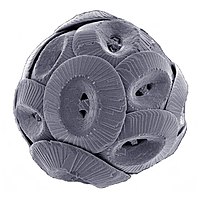
Photo from wikipedia
Soil improvement techniques have been developed experimentally and empirically from various geotechnical standpoints based on physical, chemical, and biological findings. The traditional microbiological perspectives consider microbially induced soil cementation as… Click to show full abstract
Soil improvement techniques have been developed experimentally and empirically from various geotechnical standpoints based on physical, chemical, and biological findings. The traditional microbiological perspectives consider microbially induced soil cementation as an environment-friendly soil improvement technique. In particular, microbially induced carbonate precipitation (MICP) is recognised as an effective method with applications in real geotechnical problems. Traditionally, highly active species with carbonate-precipitating and their optimum environmental conditions have been identified through laboratory experiments and field surveys. Recently, numerical simulations considering microbial metabolic reactions have been tried for elucidating MICP. However, the mathematical and numerical evaluation of the relationship between bacterial growth and MICP requires further investigation. This study proposed a novel numerical simulation scheme for evaluating the effects of bacterial growth on stress distribution in soil micro- and macro-structure. In particular, this scheme utilised a reaction–diffusion system to determine bacterial growth and MICP in micro-structures. Further, stress and strain distributions in multi-scale structures were evaluated by a homogenisation method. Consequently, the simulation results of the calcium carbonate precipitation were 0.85–4.5 μmol/mm3 at 10.3 h. Evidently, the model values are reasonably consistent with the experimental data. Further, the homogenisation simulations indicated that soil stabilisation could be attributed to the formation of a novel skeleton structure comprising soil particles and calcium carbonate-filled soil pores.
Journal Title: Acta Geotechnica
Year Published: 2021
Link to full text (if available)
Share on Social Media: Sign Up to like & get
recommendations!